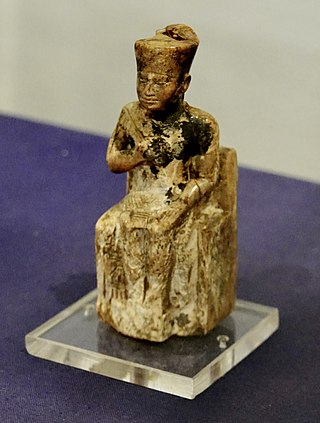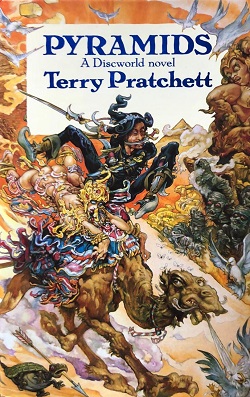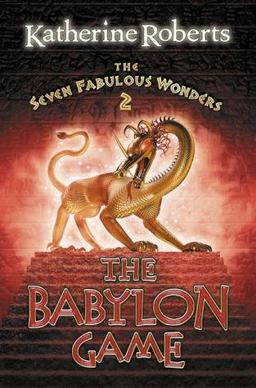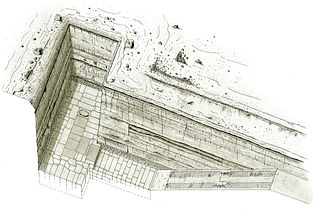
The pyramid of Djoser, sometimes called the Step Pyramid of Djoser, is an archaeological site in the Saqqara necropolis, Egypt, northwest of the ruins of Memphis. It is the first pyramid to be built. The 6-tier, 4-sided structure is the earliest colossal stone building in Egypt. It was built in the 27th century BC during the Third Dynasty for the burial of Pharaoh Djoser. The pyramid is the central feature of a vast mortuary complex in an enormous courtyard surrounded by ceremonial structures and decoration.

Khufu or Cheops was an ancient Egyptian monarch who was the second pharaoh of the Fourth Dynasty, in the first half of the Old Kingdom period. Khufu succeeded his father Sneferu as king. He is generally accepted as having commissioned the Great Pyramid of Giza, one of the Seven Wonders of the Ancient World, but many other aspects of his reign are poorly documented.

Pyramids is a fantasy novel by British writer Terry Pratchett, published in 1989, the seventh book in his Discworld series. It won the BSFA Award for Best Novel in 1989.

Katherine Alice Applegate, known professionally as K. A. Applegate, is an American young adult and children's fiction writer, best known as the author of the Animorphs, Remnants, and Everworld book series. She won the 2013 Newbery Medal for her 2012 children's novel The One and Only Ivan. Applegate's most popular books are science fiction, fantasy, and adventure novels. She won the Best New Children's Book Series Award in 1997 in Publishers Weekly. Her book Home of the Brave has won several awards. She also wrote a chapter book series in 2008–09 called Roscoe Riley Rules.

The Egyptian pyramids are ancient masonry structures located in Egypt. Sources cite at least 118 identified "Egyptian" pyramids. Approximately 80 pyramids were built within the Kingdom of Kush, now located in the modern country of Sudan. Of those located in modern Egypt, most were built as tombs for the country's pharaohs and their consorts during the Old and Middle Kingdom periods.

The Fourth Dynasty of ancient Egypt is characterized as a "golden age" of the Old Kingdom of Egypt. Dynasty IV lasted from c. 2613 to 2494 BC. It was a time of peace and prosperity as well as one during which trade with other countries is documented.

The pyramid of Menkaure is the smallest of the three main pyramids of the Giza pyramid complex, located on the Giza Plateau in the southwestern outskirts of Cairo, Egypt. It is thought to have been built to serve as the tomb of the Fourth Dynasty Egyptian Pharaoh Menkaure.

The Giza pyramid complex in Egypt is home to the Great Pyramid, the Pyramid of Khafre, and the Pyramid of Menkaure, along with their associated pyramid complexes and the Great Sphinx. All were built during the Fourth Dynasty of the Old Kingdom of ancient Egypt, between c. 2600 – c. 2500 BC. The site also includes several temples, cemeteries, and the remains of a workers' village.

The Lost Symbol is a 2009 novel written by American writer Dan Brown. It is a thriller set in Washington, D.C., after the events of The Da Vinci Code, and relies on Freemasonry for both its recurring theme and its major characters.
Katherine Roberts is an English author, best known for her fantasy trilogy The Echorium Sequence. She spent most of her childhood in Devon and Cornwall, England. She is the daughter of Derek Robert, an electrical engineer, and Dorothy Margaret, a teacher.
The Indestructibles was the name given by ancient Egyptian astronomers to two bright stars which, at that time, could always be seen circling the North Pole. The name is directly related to Egyptian belief in constant North as a portal to heaven for pharaohs, and the stars' close association with eternity and the afterlife. These circumpolar stars are now known as Kochab, in the bowl of Ursa Minor or, the Little Dipper, and Mizar, in Ursa Major, at the middle of the handle of the Big Dipper.

Nebka is the throne name of an ancient Egyptian pharaoh of the Third Dynasty during the Old Kingdom period, in the 27th century BCE. He is thought to be identical with the Hellenized name Νεχέρωχις recorded by the Egyptian priest Manetho of the much later Ptolemaic period.

The Babylon Game is a fantasy novel by British writer Katherine Roberts, the second book in The Seven Fabulous Wonders series and the sequel to The Great Pyramid Robbery.
The Seven Fabulous Wonders is a fantasy series by Katherine Roberts currently comprising seven novels. The novels are based on the Seven Wonders of the Ancient World.

The Buried Pyramid is an unfinished step pyramid constructed c. 2645 BC for Sekhemkhet Djoserty. He was the second pharaoh of the Third Dynasty of Ancient Egypt, which reigned over Egypt c. 2686–2613 BC and is usually placed at the beginning of the Old Kingdom of Egypt. Many historians believe that the third dynasty played an important role in the transition from Early Dynastic Period of Egypt to the Age of the Pyramids.

The Red Pyramid is a 2010 fantasy-adventure novel based on Egyptian mythology written by Rick Riordan. It is the first novel in The Kane Chronicles series. The novel was first published in the United States on May 4, 2010, by Hyperion Books for Children, an imprint of Disney Publishing Worldwide. It has been published in hardcover, audiobook, ebook, and large-print editions, and has been translated into 19 languages from its original English.

Bikheris is the Hellenized name of an ancient Egyptian pharaoh, who may have ruled during the 4th Dynasty around 2570 BC. Next to nothing is known about this ruler and some Egyptologists even believe him to be fictitious.

The Unfinished Northern Pyramid of Zawyet El Aryan, also known as Pyramid of Baka and Pyramid of Bikheris is the term archaeologists and Egyptologists use to describe a large shaft part of an unfinished pyramid at Zawyet El Aryan in Egypt. Archaeologists are generally of the opinion that it belongs to the early or the mid-4th Dynasty during the Old Kingdom period. The pyramid owner is not known for certain and most Egyptologists, such as Miroslav Verner, think it should be a king known under his hellenized name, Bikheris, perhaps from the Egyptian Baka. In contrast, Wolfgang Helck and other Egyptologists doubt this attribution.
Papyrus Ambras is a papyrus which was formerly in the collection of Ambras Castle near Inssbruck, and is now a part of the collection of the Vienna Museum. The first to draw attention to it was the Egyptologist Heinrich Karl Brugsch, who published about it in 1876.

The pyramid of Nyuserre is a mid-25th-century BC pyramid complex built for the Egyptian pharaoh Nyuserre Ini of the Fifth Dynasty. During his reign, Nyuserre had the unfinished monuments of his father, Neferirkare Kakai, mother, Khentkaus II, and brother, Neferefre, completed, before commencing work on his personal pyramid complex. He chose a site in the Abusir necropolis between the complexes of Neferirkare and Sahure, which, restrictive in area and terrain, economized the costs of labour and material. Nyuserre was the last king to be entombed in the necropolis; his successors chose to be buried elsewhere. His monument encompasses a main pyramid, a mortuary temple, a valley temple on Abusir Lake, a causeway originally intended for Neferirkare's monument, and a cult pyramid.
















